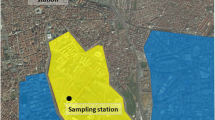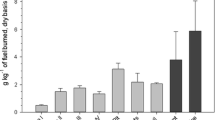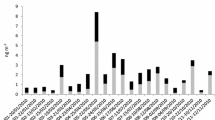Aluminum production is one source of atmospheric polycyclic aromatic hydrocarbons (PAHs), of which benzo[a]pyrene is the best-studied representative. Other high-priority PAHs are attracting increasing attention for differentiation of PAH emissions and sources. Monitoring of these compounds is difficult because PAHs are present in both the solid-phase and gas-phase emissions (with the solid phase containing condensed PAHs); the gas-phase concentration of these substances depends on the manufacturing process temperature and the temperature of the environment. Atmospheric PAH emissions primarily originate from the pot-room ventilation skylights and gas-treatment-unit smokestacks. Low-molecularweight compounds dominate the gas emissions from the pot-room ventilation skylights and posttreatment emissions, while higher molecular weight compounds dominate the gas/dust/air mixture received for treatment. The gas/dust/air mixture received from the pot rooms for treatment by the gas treatment unit and discharged into the atmosphere through the smokestacks shifts the distribution of PAHs present in the atmosphere in favor of light, volatile compounds. The PAHs are close to uniformly distributed between the gas and solid phases of the gas/dust/air mixture emitted from the pot-room skylights. Over 70 wt.% of the PAHs in the emissions downstream of the gas treatment unit are in the gas phase, while the majority of the PAHs entering the gas treatment unit are in the solid phase. The resulting PAH distribution data for the gas/air mixture must be taken into account when developing the techniques for sampling the industrial emissions from the skylights and the atmospheric emissions downstream of the gas treatment unit during aluminum production.







Similar content being viewed by others
References
Some non-heterocyclic polycyclic aromatic hydrocarbons and some related exposures: IARC Monographs on the Evaluation of Carcinogenic Risks to Humans, vol. 92, p. 868 (2010); http://monographs.iarc.fr/ENG/Monographs/vol92/ mono92-1.pdf
L. Kurteeva, S. Morozov, and A. Anshits, “The sources of carcinogenic PAH emission in aluminium production using Soderberg cells,” in: Advances in the Geological Storage of Carbon Dioxide, Springer, Dordrecht (2006), pp. 57–65.
V. Samburova, B. Zielinska, and A. Khlystov, “Do 16 polycyclic aromatic hydrocarbons represent PAH air toxicity?,” Toxics 5, No. 3, 17 (2017); https://www.ncbi.nlm.nih.gov/pmc/articles/PMC5634701/pdf/toxics-05-00017.pdf
Procedure for Measuring the Mass Fraction of Resinous Substances (Coal-Tar Asphalt Distillates) in Industrial Emissions by the Spectral Fluorescence Method, MVI No. SPEhK-14-2004, OOO LiI, Saint Petersburg (2004), p. 31.
Procedure for Measuring the Mass Fraction of Benz[a]pyrene in Emissions from Aluminum and Electrode Plants [in Russian], MVI No. PrV 2000/1, AO VAMI, Saint Petersburg (2000), 24 pp.
Procedure for Measuring the Mass Fraction of Benz[a]pyrene in Industrial Emissions by a Spectrofluorometric Method [in Russian], MVI No. SPEhK-12-2004, OOO LiI, Saint Petersburg (2004), 31 p.
E. Stogiannidis and R. Laane, “Source characterization of polycyclic aromatic hydrocarbons by using their molecular indices: an overview of possibilities,” Rev. Environ. Contam. Toxicol., 234, 49–133 (2015).
M. Tobiszewski and J. Namieśnik, “PAH diagnostic ratios for the identification of pollution emission sources,” Environ. Pollut. (Oxford, U. K.), 162, 110–119 (2012).
T. J. Robare and M. W. Wei, “Control of pitch volatiles in green electrode production,” in: Light Metals 2018 (1984), pp. 1521–1529 .
O. S. Kjos, T. A. Aarhaug, B. Wittgens, and A. Brunsvik, “At-line analysis of polycyclic aromatic hydrocarbons in aluminium primary production Brunsvik,” in: Light Metals 2014, Springer (2014), pp. 541–546.
“OSPAR Commission 2002: Emissions and Discharges of Polycyclic Aromatic Hydrocarbons (PAHs) from Primary Aluminium Electrolysis, Soederberg Technology,” OSPAR Commission (2002).
R. Glaus and A. Steinegger, “Contribution to the Interpretation of Coal Tar Pitch Measurements at the Workplace,” in: Light Metals 1984 (1984), pp. 1553–1568 .
T. Eidet, K. Forslund, R. Pedersen, and M. Sorlie, “PAHs and emissions of pitch vapor from the surface of Soderberg anodes,” Tekhnikoehkonomicheskii Vestnik RUSALA, No. 11, 33–37 (2005).
T. Rengarajan, P. Rajendran, N. Nandakumar, B. Lokeshkumar, P. Rajendran, and I. Nishigaki, “Exposure to polycyclic aromatic hydrocarbons with special focus on cancer,” Asian Pac. J. Trop. Biomed., 5, 182–189 (2015).
L. Mu, L. Peng, J. Cao, Q. He, F. Li, J. Zhang, X. Liu, and H. Bai, “Emissions of polycyclic aromatic hydrocarbons from coking industries in China,” Particuology, 11, 86–93 (2013).
Author information
Authors and Affiliations
Corresponding authors
Additional information
Translated from Metallurg, Vol. 63, No. 11, pp. 77–83, November, 2019.
Rights and permissions
About this article
Cite this article
Taranina, O.A., Burkat, V.S. & Volkodaeva, M.V. Analysis of the Concentration of Gas-Phase and Solid-Phase Polyaromatic Hydrocarbons in Industrial Emissions from Aluminum Production. Metallurgist 63, 1227–1236 (2020). https://doi.org/10.1007/s11015-020-00945-6
Received:
Published:
Issue Date:
DOI: https://doi.org/10.1007/s11015-020-00945-6




